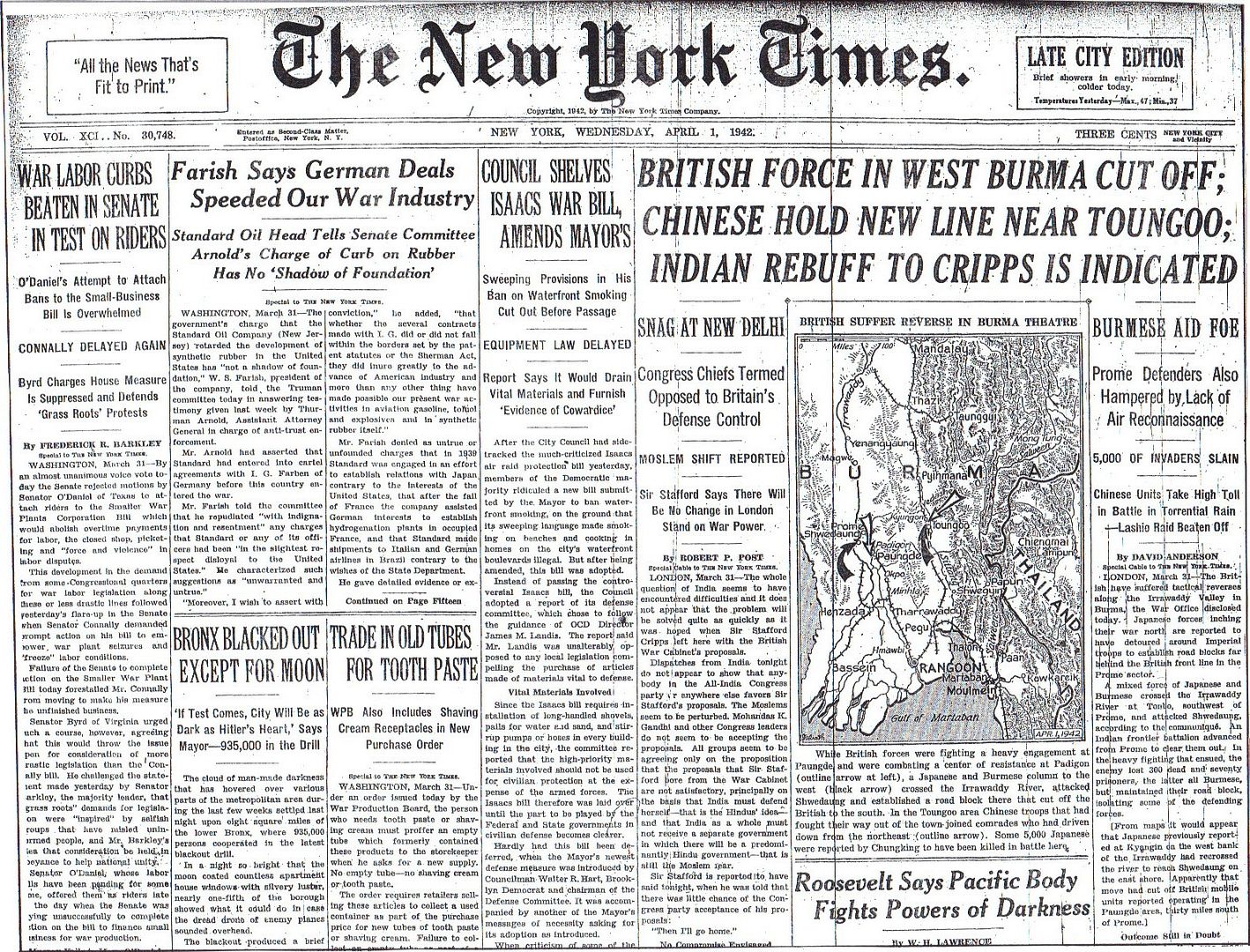
Posted on 04/01/2012 5:06:41 AM PDT by Homer_J_Simpson

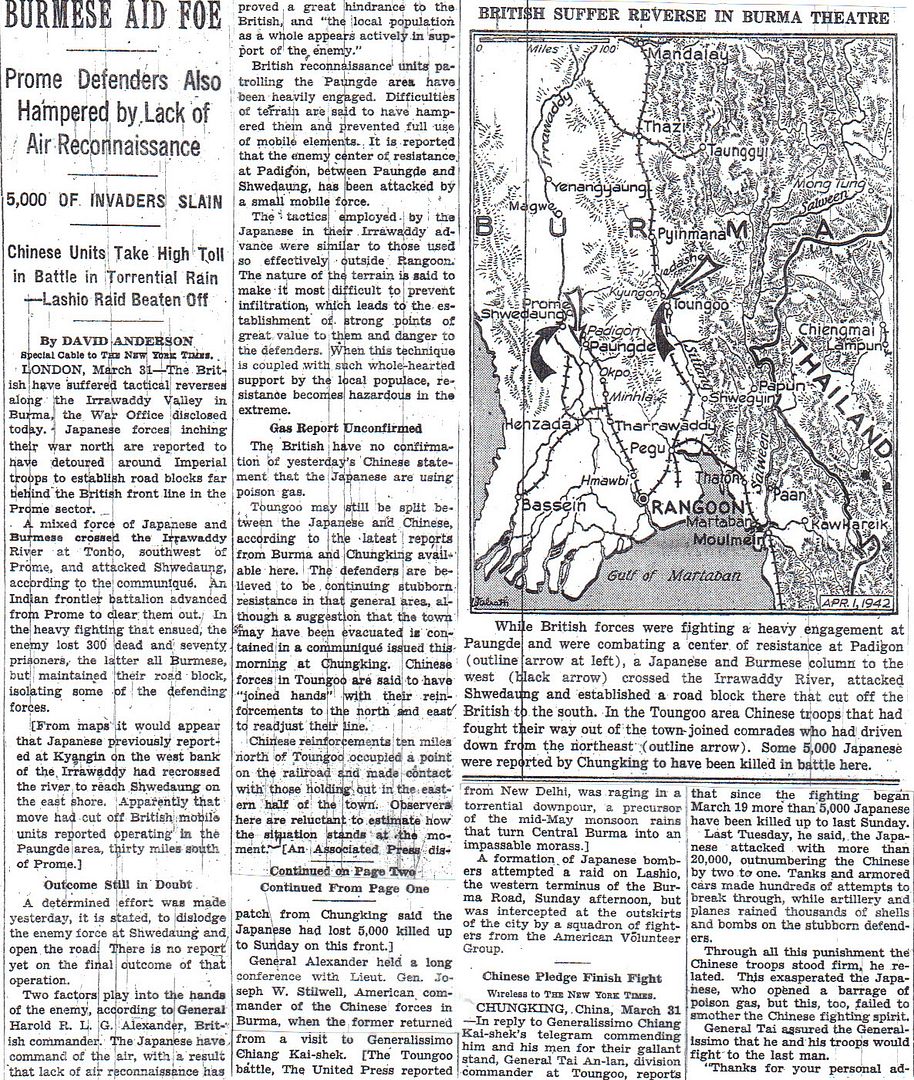



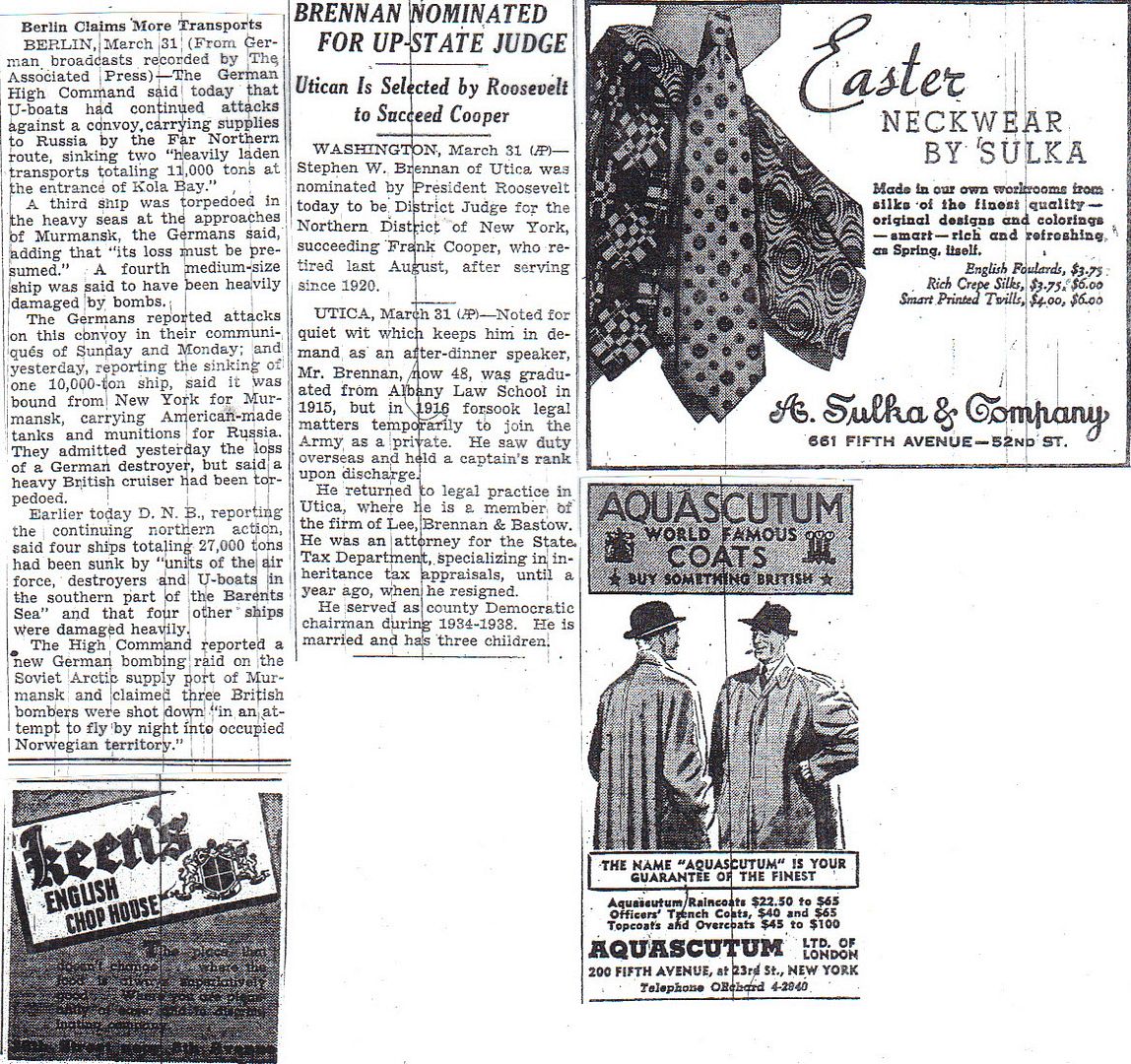

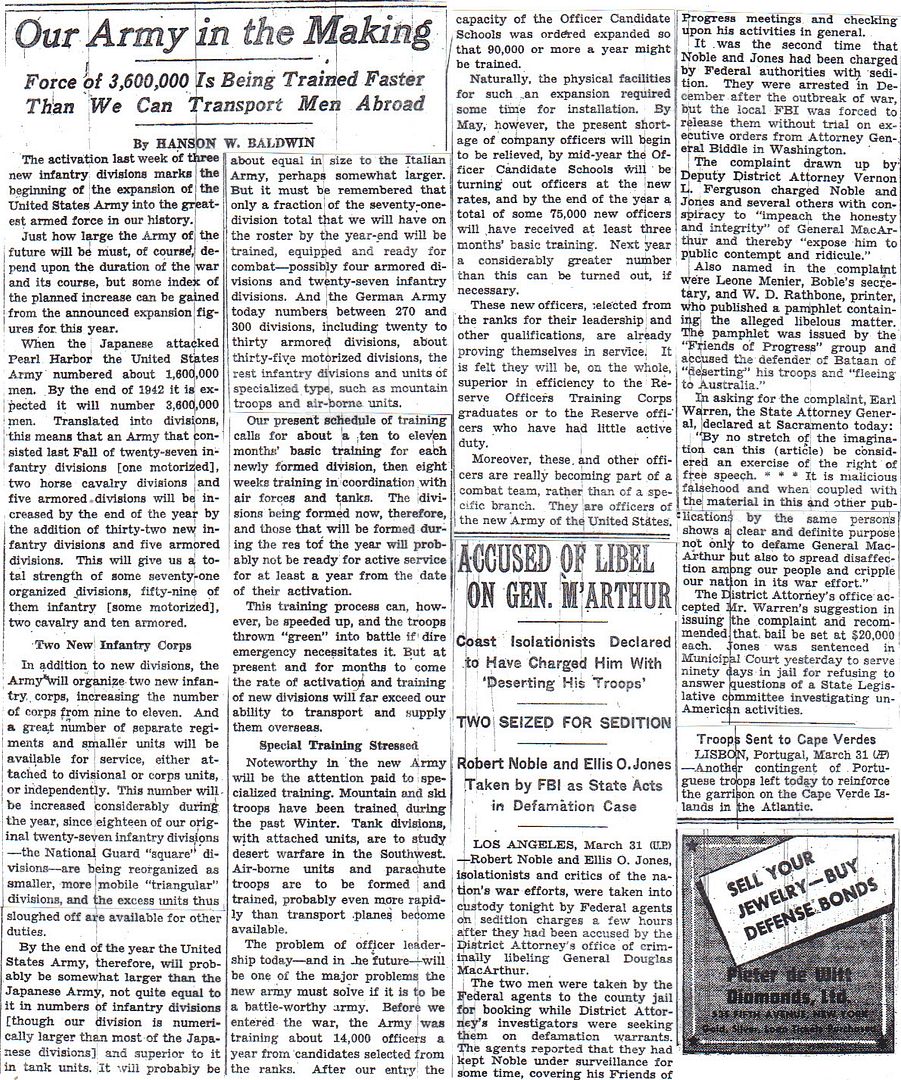
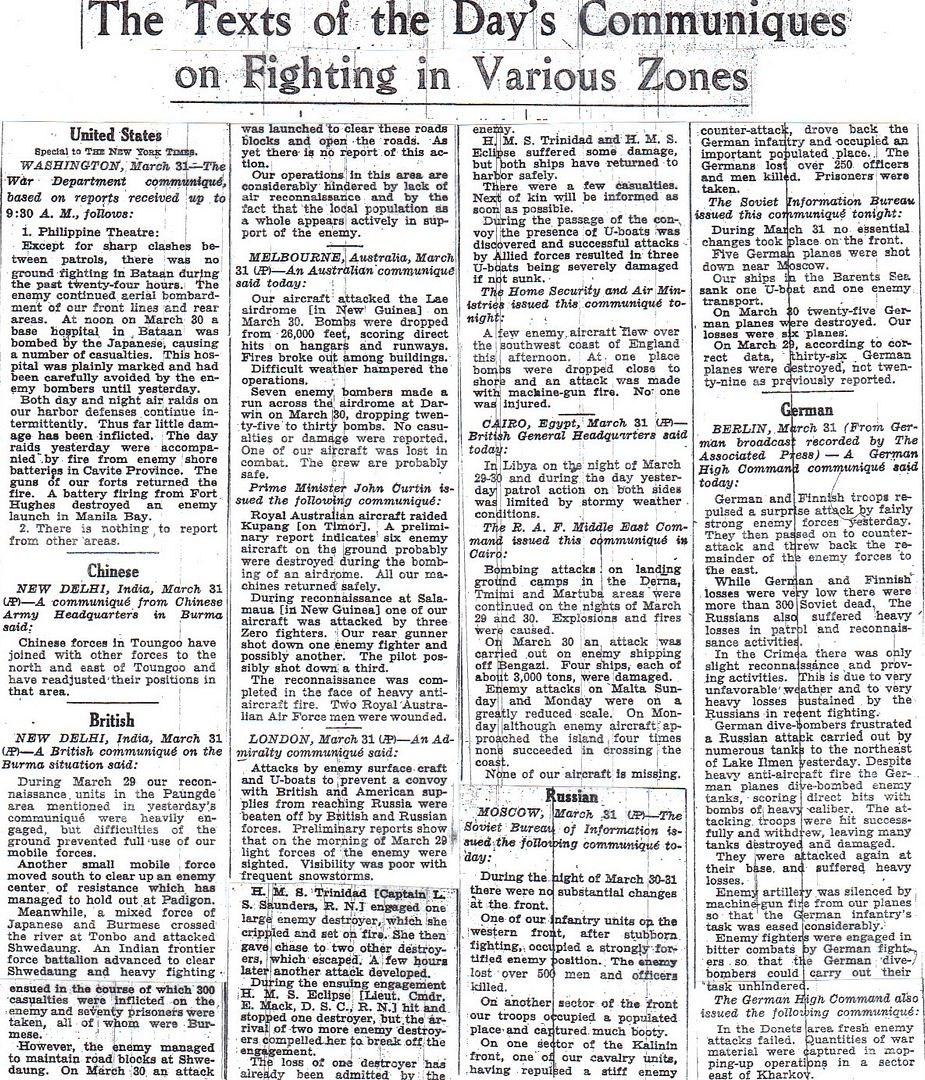

* These two isolationists will be charged today. Read more on pg. 8 of tomorrow’s post.
http://www.onwar.com/chrono/1942/apr42/f01apr42.htm
Chinese and British under attack in Burma
Wednesday, April 1, 1942 www.onwar.com
Japanese infantry attack in BurmaIn Burma... Japanese advances near Toungoo continue and the Chinese are forced to retreat. The Japanese also heavily attack British positions near Prome.
In the Philippines... the Japanese resume major attack on the Bataan Peninsula. The American and Philippine troops have 24,000 of the their men ill due to short rations (1/4 of normal ration size) and tropical diseases.
In the Mediterranean... The Italian cruiser Bande Nere is sunk by the British submarine Urge north of Sicily.
From London... Admiral Cunningham is appointed to serve on the Combined Chiefs of Staff Committee in Washington, he leaves the post of commander of the British Mediterranean Fleet.
In New Guinea... Japanese invasion of New Guinea continues with landings at Sorong and Hollandia. They go almost unopposed.
http://homepage.ntlworld.com/andrew.etherington/frame.htm
April 1st, 1942
UNITED KINGDOM: London: Admiral Sir Andrew Cunningham of the Commander-in-Chief of the British Mediterranean Fleet is appointed to serve on the Combined Chiefs of Staff Committee in Washington D.C. relinquishing his command in the Mediterranean.
FRANCE: During the day, RAF Bomber Command dispatches 12 Bostons to attack a “Q-ship” at Boulogne; clouds are encountered and the dock area is bombed instead. A Boston is lost. During the night, two targets are hit: (1) 34 Wellingtons and 22 Hampdens are dispatched to attack the port area at Le Havre; 46 bomb and successful bombing is claimed. One Wellington is lost. (2) Twenty four Whitleys and 17 Wellingtons are dispatched to bomb the Ford Motor Co. factory in the Paris suburb of Poissy; 34 aircraft attack and crews claim accurate bombing but this is not confirmed by a later photographic flight. A Wellington is lost. Other missions during the night are (1) 11 aircraft laying mines off Lorient and in the mouth of the River Gironde and (2) five aircraft dropping leaflets. (Jack McKillop)
GERMANY: Berlin: The Nazis have drawn up a set of rules for disposing of the possessions looted from Jews, down to the last fountain-pen.
They have decreed that German Mark are to be paid into the bank account of the SS’s administration department, which runs the concentration camps. Foreign currency, precious metals, jewellery and dental gold are to be handed over to the SS for transfer to the Reichsbank. Alarm clocks, pocket knives, scissors, wallets and fountain-pens will be sold to troops at the front.
During the night of the 1st/2nd, RAF Bomber Command dispatches 35 Wellingtons and 14 Hampdens to carry out low-level attacks on railway targets. Nine aircraft attack the marshalling yard at Hanau but 12 Wellingtons and a Hampden are lost en route. In other attacks, three aircraft attack the city of Darmstadt and one hits Frankfurt-am-Main. No 57 Squadron based at Feltwell, Norfolk, England, lost five of the 12 Wellingtons dispatched while No. 214 Squadron at Stradishall, Suffolk, England, lost seven of 14 Wellingtons. (Jack McKillop)
SWEDEN: Operation Performance kicks off as eleven Norwegian merchant ships in the port of Gothenberg try to flee through the Skagerrak (the body of water between Norway and Denmark) to Britain. Five are sunk before they clear the Skagerrak, one is too badly damaged to continue, two turn back, only two reach Britain. (Jack McKillop)
U.S.S.R.: A stalemate exists along the entire line. The Germans of Army Group North are largely concerned during the month with extricating II Corps of the Sixteenth Army from a pocket southeast of Staraya Russa. (Jack McKillop)
Murmansk: The battered convoy PQ-13 arrived here today. Five of the 19 merchant ships which began the voyage had been sunk, two by U-boats, two by aircraft and one by a destroyer. The problems began on 24 March when a violent storm off Bear Island separated them from the escort of a cruiser, HMS TRINIDAD, and two destroyers.
The Luftwaffe found the unprotected ships and called in the U-boats and three destroyers from Kirkenes. The escort found its charges too late to save five of them, but it managed to destroy on of the German destroyers, Z26.
HMS TRINIDAD was crippled by a torpedo but managed to limp into Kola Inlet near Murmansk. It was only when her sailors were examining the debris in the boiler rooms that they discovered that the torpedo that hit her was her own. The severe cold had affected the steering mechanism so that it circled back.
The incident shows the hazards of the Arctic route. Sailors work in ice spray which freezes on the deck. But the improving weather now also means a bigger threat from the Germans. This spring the convoys have to cope with attacks from Germany’s most powerful battleship, the TIRPITZ, sent to these waters a few weeks ago. Yesterday a force of 34 Halifaxes set out to bomb her but failed even to find the target.
MEDITERRANEAN SEA: Submarine HMS Urge sinks the Italian light cruiser Giovanni delle Bande Nere near Stromboli Island north of Sicily.
MALTA: LAC Albert Matthew Osborne (b.1906), RAFVR, died while tackling a burning plane with the courage shown in his many similar operations on Malta. (George Cross)
MALTA: Two submarines are sunk in harbour by an air attack.
U class submarine P.36 is bombed in an air attack whilst alongside the jetty at Manoel Island, Malta and has a hole blown in her pressure hull. An attempt was made to keep the submarine afloat, but when it seemed as if the weight of the submarine might cause the arches of the submarine base structure to collapse, she was cut free and allowed to sink. In August 1958, P.36 was raised and scuttled at sea.
Submarine HMS Pandora which had brought vital stores to Malta and was being unloaded, receives two bomb hits in an air attack and sinks within four minutes. The wreck was later raised and sent to join P. 39 at Kalkara Creek. In 1957 it was being broken up when two skeletons of her crew were found in the compartment where they had died, which were then buried at sea on 1 July 1957 from HMS Tudor. (Alex Gordon)(108)
BURMA: General Archibald Wavell, Commander-in-Chief India, visiting the front, agrees to the immediate withdrawal of Burma I Corps to the Allanmyo area, north of Prome. The Japanese continue to press in on Prome. Wavell sends a message to British Prime Minister Winston Churchill stating that the Japanese command of the air is setting the Allied command in Burma an extremely difficult task. Lieutenant General William J Slim, General Officer Commanding Burma Corps, and Lieutenant General Joseph Stilwell, Commanding General American Army Forces, China, Burma and India and Chief of Staff of the Chinese Army, meet for the first time and are impressed with each other. (Jack McKillop)
CHINA: After meeting with British General William J Slim in Burma, Lieutenant General Joseph Stilwell flies to Chungking to meet with Generalissimo Chiang Kai-Shek. The meeting is stormy. Stilwell tells Chiang he will resign because the Chinese generals won’t obey his orders. “What a gag,” Stilwell writes. “I have to tell Chiang Kai Shek with a straight face that his subordinates are not carrying out his orders, when in all probability they are doing just what he tells them. In justice to all of them, however, it is expecting a great deal to have them turn over a couple of armies in a vital area to a foreigner.” (Jack McKillop)
JAPAN: Japanese Combined Fleet Headquarters submits a draft of an operational plan for the Second Phase of operations, in which the Aleutian Operation (AL-GO) will be followed by a Midway Operation. (Jack McKillop)
COMMONWEALTH OF THE PHILIPPINES: The Japanese Army resumes major attacks against the US and Filipino forces on Bataan. The 24,000 men there are on 1/4 rations and ill from food shortages and tropical diseases.
NEW GUINEA: Japanese troops from the Netherlands East Indies land at a number of points on the Dutch New Guinea coast, from Sorong on the north-western tip to Hollandia, during the period 1-20 April; the landings are virtually unopposed. (Jack McKillop)
Six USAAF A-24 Dauntlesses based at Port Moresby attack the Japanese at Lae. (Jack McKillop)
NETHERLANDS EAST INDIES: During the night of 31 March/1st, the Japanese land on Ceram Island, Netherlands East Indies. The 1st Detachment occupies the town of Fakfak and the small Dutch garrison surrenders without a fight.
RAAF Hudsons of Nos. 2 and 13 Squadrons operating from Darwin, Northern Territory, Australia, bomb Penfui Airfield on Dutch West Timor Island. The Australians destroy six and damage six aircraft on the ground. (Jack McKillop)
PACIFIC OCEAN: Submarine USS Seawolf (SS-197) torpedoes Japanese light cruiser HIJMS Naka 50 miles (80 kilometres) northwest of Christmas Island south of Java. British submarine HMS Truant sinks two Japanese merchant cargo ships in Malacca Strait, 60 miles (97 kilometres) off the coast of Sumatra. (Jack McKillop)
SOLOMON ISLANDS: Japanese forces occupy Buka Island off the north coast of Bougainville Island. (Jack McKillop)
U.S.A.: New York: Admiral Ernest J. King, the commander-in-chief of the US Navy, who has his headquarters in downtown Manhattan, has finally accepted the British view on convoys. The devastating successes of the U-boats has convinced his of this.
Ironically, the Allies have been doing less well since the US entered the war. Before then the British had established the convoy system with help from Canada and, despite its neutrality, from the US. Once the US joined the war, Admiral King took the view that “inadequately escorted convoys are worse than none”. Hundreds of ships were allowed to sail unescorted from US ports before joining convoys in mid-ocean. U-boat commanders simply moved closer to the well-lit US shore. So easy did they find it to pick off sitting targets that they called it “the American turkey-shoot.”
The US Navy has not got sufficient escort ships to guard all the shipping all the way, however. The new system requires ships to sail in convoy as close to the shore as possible during daylight hours, and to anchor at night in harbour.
US Marine Corps Photo Reconnaissance Squadrons VMD-1 and VMD-2 are organized at Naval Air Station San Diego. (Jack McKillop)
The Pacific War Council holds its first meeting at Washington, D.C. Presided over by President Franklin D. Roosevelt and attended by representatives of Australia, Canada, China, the Netherlands, New Zealand, the Philippines and the U.K., this is the first of more than 30 meetings held during the war. (Jack McKillop)
The USAAF’s Air Corps Proving Ground is redesignated Proving Ground Command, with its main base at Eglin Field, Valpariso, Florida. The command performs operational tests and studies of aircraft and aircraft equipment. (Jack McKillop)
As a result of the immense loss in shipping along the U.S. eastern seaboard, since January 1942, the U.S. authorities institute a partial convoying system, known as the “Bucket Brigade.”. This meant that ships will sail in convoy as close to the coast as possible during daylight hours and anchor in protected harbours at night. Due to the shortage of escort vessels, continuous convoying is not possible and the “Bucket Brigade” system did not apply to the Caribbean or Gulf of Mexico. (Jack McKillop)
Transport Squadron Two (VR-2), the first Naval Air Transportation Service (NATS) squadron for Pacific operations, is established at NAS Alameda, California. (Jack McKillop)
The US Navy Amphibious Force, Pacific Fleet is renamed to the Amphibious Corps, Pacific Fleet. (Gordon Rottman)
ATLANTIC OCEAN: The Allies suffered their worst shipping losses of the war last month. No fewer than 273 merchant ships were sunk, totalling 834,184 tons. The total for the first three months of the year was 1.93 million tons lost, and the vast majority of these - 1.34 million tons - were sunk by the U-boats.
GERMANY, now has 121 operational U-boats, compared with 91 at the beginning of the year, Because of the long distances they have to travel to the main battleground on the eastern seaboard of the US, there are rarely more than a dozen in position at any one time. Nevertheless, their effect has been devastating, In the first quarter of the year U-boats sank 216 ships in the North Atlantic, most of them in the area patrolled by the US Navy.
Admiral Dönitz ordered them to go for the easiest targets amongst ships which were strategically important, particularly oil tankers carrying essential fuel for the war in Europe.
More than half of the sinkings have been oil tankers. Moreover, the Germans are stepping up their efforts. The submarine building programme is being accelerated and in six months time the Allies will be reckoning with the menace of at least another 100 U-boats.
ICELAND: Nineteen merchant ships of Convoy PQ 13 set sail for the Soviet Union. They will lose five ships and one of their escorting light cruisers, HMS Trinidad, will be crippled by German torpedoes. (Jack McKillop)
wow.....on the front page of the Times, to purchase new toothpaste and/or shaving cream, one must proffer up the used tube or container.
I didnt know there was rationing for those items.
This early in the Pacific theatre, did the Japs already have Kamikaze attacks?
I notice the caption under the large photo, that they labeled the shot down plane as attempting a “suicide dive.”
After some thought, I’m thinking the War Production Board demanded exchange of the toothpaste & shaving cream receptacles because of the metal.
There was a recent article, either posted by Homer or in one of the Life Magazines issues posted by CougarGA7 once per week on Homer's thread indicating toothpaste tubes have a high tin content and should be turned in for recycling.
As a policy/strategy/tactic? No. But as early as the attack on Pearl Harbor, a Japanese flyer, his aircraft damaged, chose to crash his plane into a building. So the basic premise is there.
A common belief among pilots attacking shipping was that if you were shot up, medical help may be hours away but you are likely to bleed out in minutes. You are going to die so, you may as well go out with a bang by crashing into the ship you were attacking.
During the Battle of Midway, marine aviator capt. Richard E. Fleming (posthumus MOH) was widely believed to have crashed his SB2U Vindicator into the Japanese cruiser Mikuma although other reports have him crashing into the sea.
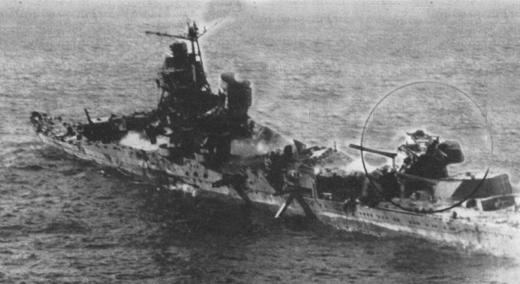
I was sorta figuring that might be the case. I saw some broadcast on History channel or Military channel not that long ago that dealt with the Kamikaze squadrons - it seemed they became organized in early 1944 if I recall correctly.
Wow...amazing pic. thanks.
Lt. Gay:
Well, yes, I dropped the torpedo and was fortunate enough to get away from the anti-aircraft fire although everything was shooting at me. I flew right down the gun barrel on one of these big pom poms up forward. I think it must have been about 20 mm. stuff. I looked in the sights and tried to get a shot at that fellow, but my gun was jammed by then and I figured the only say that I could evade all that anti-aircraft fire was not to throw my belly up in a turn away from the ship, but was just to go right straight to her and offer as small a target as I could. So I flew right down the gun barrels, pulled up on the port side, did a flipper turn right by the island, I could see the little Jap captain up there jumping up and down raising heel, and I thought about wishing that I had a .45 so that I could take a pot shot at him. I couldn't hit him, but, if nothing else, thrown the gun at him, just something, but I then dropped right back down on the deck and flew aft looking at these airplanes.
By the way, I had a thought right in a split second there to crash into those planes. That I don't feel is any suicidal instinct at all. I know that if I had been shot up to the extent where I felt that I'd only go over those planes and fall in the ocean on the other side, feeling that I was pretty near gone, just a matter of seconds, that I would have crashed right into those planes, because I could have started a beautiful fire and I figured that's the way the Japs do it when they crash into a ship. It's when a fellow is just gone and knows it, it is just crash into the ship or crash into the sea, and you have enough control to do a little bit more damage, why you crash into the ship.
I dropped down after going over these ships, I didn't feel very badly, I had a left leg that was burned and a left arm that was gone, the plane was still flying and I felt pretty good and I didn't see any sense in crashing into those planes. I though maybe I'd get a chance to go back and hit them again someday and as long as there's life there's hop, so I pulled up and went over them, dropped back down next to the water, just after I passed over the fantail and then I heard the torpedo go off. just a little bit after that then anti-aircraft fire hadn't picked up anymore, but the Zeros jumped on me and I was trying to get out of the fleet. Before I got away from them though, the five Zeros dived right down on me in a line and about the second or third one shot my rudder control and ailerons out and I pancaked into the ocean. The hood slammed shut, I couldn't keep the right wing up. It had hit the water first and snapped the plane in, and bent it all up and broke it up and the hood slammed shut and it was in the sprained fuselage. I couldn't hardly get it open. That's when I got scared. I was afraid I was going to drown in the plane.
http://www.ibiblio.org/hyperwar/USN/ships/logs/CV/cv8-EnsGay.html
Disclaimer: Opinions posted on Free Republic are those of the individual posters and do not necessarily represent the opinion of Free Republic or its management. All materials posted herein are protected by copyright law and the exemption for fair use of copyrighted works.